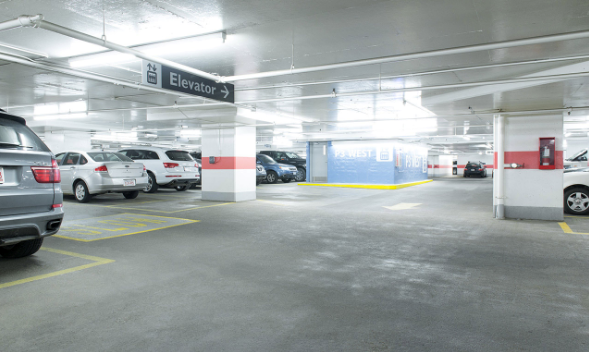With the supply of parking spots in condos and rental apartment buildings going significantly underused, it’s time to rethink parking requirements, according to a study by Metro Vancouver and TransLink that was reviewed at a regional planning meeting March 8.
Examining the results of the Parking Facility Survey and Household Survey, the study found that:
• in strata apartment buildings, parking supply exceeds use by 42 per cent;
• in market rental apartment buildings, parking supply exceeds use by 35 per cent; and
• in mixed-tenure apartment buildings, parking supply exceeds use by 41 per cent.
The study authors said that “parking supply exceeds utilization in strata and rental apartment buildings across the region” – especially in buildings that are near transit. In turn, transit use is higher among residents who live in a building with lower use of parking spots. The report said, “Transit boardings (bus boardings within 400 metres of the apartments; SkyTrain/SeaBus boardings within 800 metres of the apartments) are higher when apartment residential parking utilization is lower.”
It also found that developers are already responding to the oversupply, saying that parking supply “appears to be declining for newer strata and market rental apartment buildings.”
The study said that the home types with the largest oversupply of parking were the smallest market rental units – studios or units of less than 600 square feet.
The report made eight recommendations:
1. Treat On‐Site and Street Parking as a System: A more holistic approach toward parking supply and parking demand management for new apartment projects is warranted. Attention should be paid to the availability, type, and relative permanence of street parking (e.g. free, paid, permit‐only, and / or time-limited) and surrounded land uses, in association with any reductions in on‐site parking requirements.
2. Encourage Parking Supply to Match Demand Near the Frequent Transit Network: Parking requirements should be set based on actual or expected demands with further reductions based on transportation demand management measures or other site‐specific conditions.
3. Encourage Parking Unbundling/Opt‐Out: Selling parking stalls separate from apartments or allowing consumers to opt out of a parking stall will increase choice, and provide the opportunity for consumers without cars to realize some modest improvement in affordability.
4. Encourage Rental Apartments Near the Frequent Transit Network: Apartment renters generally have lower parking demands than do owners, and living close to the Frequent Transit Network provides an opportunity to be less reliant on a private vehicle. For these reasons, it makes sense to encourage the development of more rental apartment units close to the Frequent Transit Network.
5. Encourage Expansion of Car Share Programs where Feasible: Municipalities and developers should encourage car share providers to expand beyond current operating boundaries to such places as emerging Urban Centres and Frequent Transit Development Areas in suburban areas wherever practical and feasible.
6. Consider Allowing Amendments to Parking Supply after Pre‐Sales: It is often only after apartment pre‐sales that developers have better data to support modifications to residential parking supply. By adapting municipal processes to accommodate amendments before construction, the parking efficiency of new apartment developments can be improved.
7. Conduct Regular Post‐Occupancy Surveys: Regular and frequent post‐occupancy surveys of apartment projects should be conducted to provide timely information on parking demand in recently built and fully‐occupied apartment developments.
8. Coordinating Frequent Transit Network Expansion: Uncertainties in the future stop or station locations of the Frequent Transit Network, and the staging of expansion, can be addressed effectively through enhanced collaboration and information sharing between TransLink and municipal partners.
The Urban Development Institute has been lobbying municipal governments to relax parking requirements on new developments for years. Anne McMullin, president and CEO, said, “Each parking spot in a concrete high rise adds between $20,000 and $45,000 to the cost of construction, plus maintenance costs, and is included in the cost of the home. According to theMetro Vancouver study,the current supply of parking in strata buildings far exceeds the demand... With numbers as striking as this, it’s easy to imagine the magnitude of benefits we’d all receive – municipalities, builders, residents and the broader community – by reducing the amount of space dedicated to parking. Of the households who don’t own a vehicle, 36 per cent of them would have preferred to purchase or rent their unit without a parking stall if it meant a reduction in price, according to the study.”
More information can be found on the Metro Vancouver website here.



